L-Arginase typically exhibits optimal activity at pH 9.5 and 37 °C. While the product is likely to retain some degree of potency, the enzymatic activity of this material at neutral pH has not been determined. The enzyme is known to be rapidly inactivated at pH values below 6, according to "The Reversible Inactivation of Rat-Liver Arginase at Low pH". Please see the link below, Figure 1, which shows the Inactivation of arginase at different pH values:
https://febs.onlinelibrary.wiley.com/doi/pdf/10.1111/j.1432-1033.1972.tb01809.x
Please see the link below to review an additional article highlighting the relationship between pH and mouse liver arginase.
https://www.jstage.jst.go.jp/article/biochemistry1922/45/12/45_12_1011/_pdf















